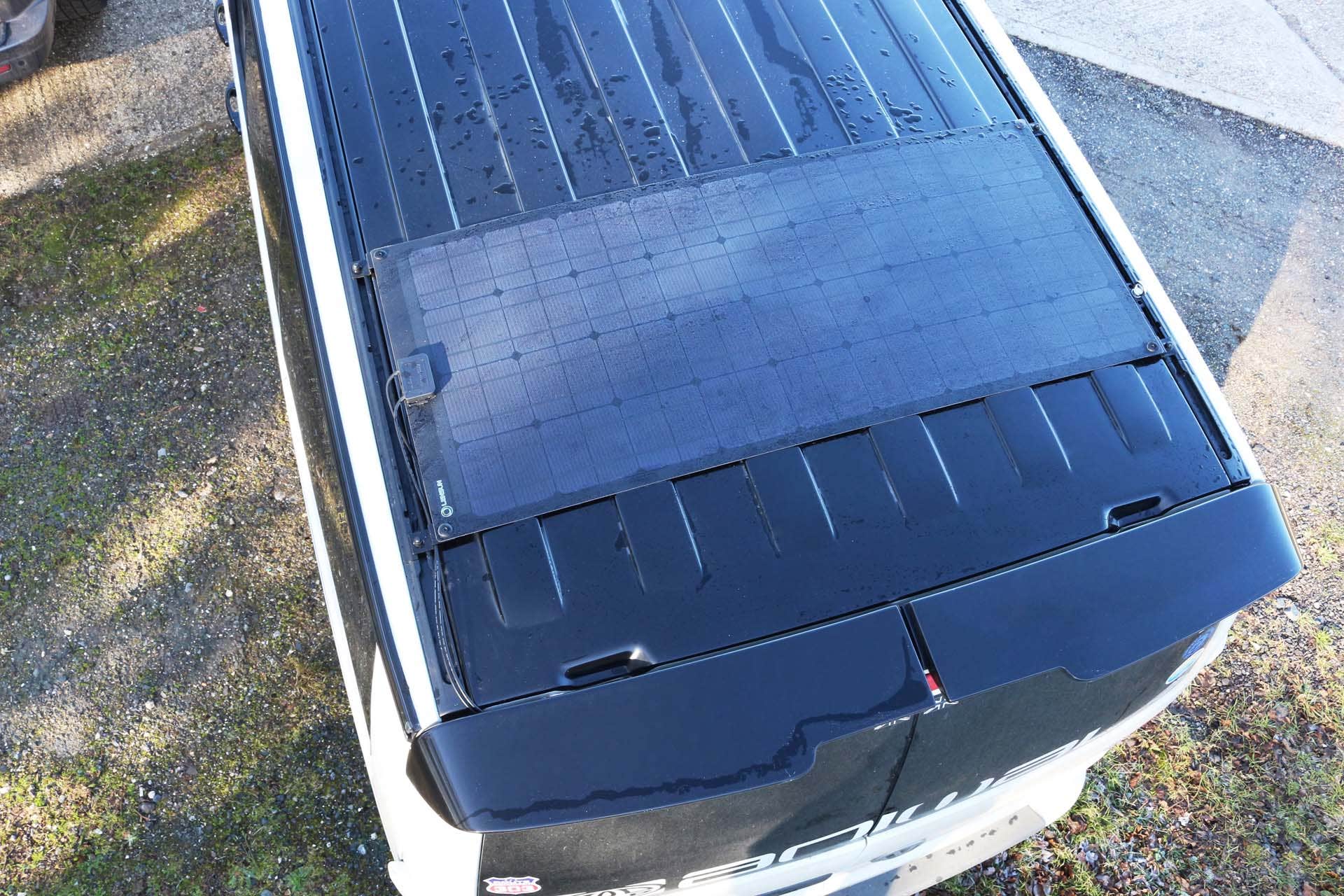As the world becomes more and more in tune with environmental issues, alternative energy sources continue to be a hot topic. One popular and practical method of using renewable energy is with solar panels – both at home, and while out and about in your campervan. While installing a solar panel on your camper can be a great advantage, there are all sorts of aspects that must be considered. Read on to find out everything you need to know about solar panels for campervans.
How much solar power do I need for a camper van?
Unfortunately, there is no one-size-fits-all solar panel for every Camper Van. To determine what type you need, you first need to work out how much solar power you need for your camper.
Working out the energy requirements of your camper
There are two main ways to figure out how much energy you need to run all the appliances in your camper.
1 – Look at your leisure battery
If you use your leisure battery for power and see how long it lasts, you can work out how much power was needed. You also need to know the Ah rating of your battery (this will likely be 110 or 200Ah). For example, if your 110AH battery powered everything you needed it to, for two days, your calculation would be 110 / 2 = 55Ah per day.
2 – Add up the power requirements of every appliance
Perhaps a more reliable way to determine how much power you need for your camper is to consider the power use of all the electrical devices you will be using while you camp. Work this out using the table below:
| Appliance | Power rating in watts (W) | Current drawn at 12V in amps (A) | Number of hours appliance is on | Amp hours (Ah) required | Energy top-up per day in watt hours (Wh) |
|---|---|---|---|---|---|
| (Power/12) | (Current x hours) | (Power x hours) | |||
| Living Area Light (each) | 16 | 1.3 | 3 | 3.9 | 48 |
| Halogen downlighter (each) | 10 | 0.8 | 2 | 1.6 | 20 |
| Kitchen Ventilation Fan | 20 | 1.7 | 0.5 | 0.9 | 10 |
| Water Pump | 40 | 3.3 | 0.2 | 0.7 | 8 |
| 14in 12V colour television | 45 | 3.8 | 2 | 7.5 | 90 |
| 12V Radio | 24 | 2 | 2 | 4 | 48 |
| Total | 18.7Ah | 224Wh |
Calculating power use – an example
Power (Watts) = Current (Amps or A) x Voltage (Volts or V)
Your battery produces roughly 12 Volts, so to work out how much your appliances drain the battery, use the appliances’ power rating, i.e. Watts / 12
For example, an IE A Waeco CR50 Fridge has a power rating of 40 Watts, so:
40W / 12 = 3.33A
Then, multiply this figure by the number of hours it will be used. For example, 24 hours in the case of the fridge:
3.33A x 24 hours = 79.92 Ah
This means that 79.92 Watt-hours from the battery are used to run the appliance.
When you have totalled up how much power you need, next you can determine what size solar panel to get for your campervan. It’s the Wh (watt hours) figure you need to know.
What size solar panel for campervan
In the UK, solar panels are marked with a power rating, to help you decide which you need. This details how much power the panel will provide under standard test conditions. The power rating is generally between 4W and 150W. Depending on the amount of sunshine, you can expect anything from just 3.2Wh to about 1000Wh.
| Solar panel rating | Summer power generation over a 24-hour period | Winter power generation over a 24-hour period |
|---|---|---|
| 4W | 24-28Wh | 3.2Wh |
| 10W | 60-70Wh | 8Wh |
| 20W | 120-140Wh | 16Wh |
| 25W | 150-175Wh | 20Wh |
| 50W | 300-350Wh | 40Wh |
| 80W | 480-560Wh | 64Wh |
| 100W | 600-700Wh | 80Wh |
| 150W | 900-1050Wh | 120Wh |
With information about how much power (Wh) you need to use per day, you can identify which solar panel rating you require. Remember to consider things like when you are likely to travel, and therefore how much sun the panel is likely to be exposed to.
How to install solar panels on a campervan
You can choose from fixed or folded solar panels to use on a campervan. Folding solar panels are very simple and versatile, which are ideal for those who do not want to commit to using a solar panel. Fixed ones, on the other hand, are more permanent. Once installed, however, fixed solar panels require little attention.
Installing a fixed solar panel
The optimum place to install a fixed solar panel is to the roof of your camper, however, you need to consider which position is best. Think about which part of the roof is likely to see the most sun, and also consider the placement of the cabling connections. Watch our video to see exactly how to install a fixed solar panel:
Using a folding solar panel
Folding solar panels are free-standing, and do not require installation apart from a simple connection:
What are the best solar panels for a campervan?
There are a number of solar panels to choose from, not only fixed or folded, and different power ratings, but also Thin Film or Crystalline.
Crystalline solar panels
There are a number of solar panels to choose from, not only fixed or folded, and different power ratings, but also Thin Film or Crystalline.
Crystalline solar panels
Crystalline solar panels are either monocrystalline or polycrystalline. The difference between them is the composition of the silicon substrate that makes up the solar cells.
In Monocrystalline panels, each cell is made up of one single crystal. This makes it more efficient and therefore reduced the size required.
In Polycrystalline panels, each cell is made up of numerous crystals. This makes it less efficient, so you would require a larger panel. Due to the easier manufacturing process, polycrystalline panels are often the cheaper option.
Thin-Film solar panels
Thin film solar panels are far less expensive than crystalline ones, because they use a thin layer of semiconductor material on the surface – rather than integral crystals. They are however, much less efficient, which means you’d require a panel with a large surface area. They also have a lower life expectancy.
Just Kampers Recommendations
We've trialled a lot of different solar panels in our quest to bring the best ones into our range here at JK.
Depending on your needs and preferences, we recommend either:
100W Ultralight Fold Up Solar Panel
This is extremely simple to use and is perfect for those who need some flexibility.
Being lightweight, it can easily be moved to different spots according to where the sun is directed.
Plus, it’s a monocrystalline solar panel, which means it’s efficient and reliable!
100W Solar Panel Roof Mount Kit (Hidden Outlet)
For campers who would rather have a permanent source of solar power, we recommend this fixed, polycrystalline option.
It’s easy to install and is made using a flexible material, meaning it can curve according to the shape of the campervan.
See our full range of solar panels to browse through your options.
Our new and exclusive JK Solar Charging Screen is one of the coolest products we’ve made in our 30+ year history!
Designed by JK and Texenergy, it’s a fantastic way to ensure that your main vehicle battery, and your leisure battery, never runs out of juice.
The solar charger screen folds out to cover your vehicle’s windscreen, and captures huge amounts of energy from the sun before converting it into electricity.
It can be mounted on the inside or outside of the vehicle, and can be plugged directly into your 12v power supply or used to top up and recharge your mobile phone, laptop and other gear.
We're so proud with the work we've put into designing and refining the JK Solar Charging Screen, and so happy with the end result, that we've applied for registered design status: application number 6196983.
The beauty of a solar panel is that you can use multiple appliances in your campervan without needing to worry about electric hook up.
The combination of one of our 100W solar panels, with a 110Ah (or larger) battery, means you can enjoy using your electrical devices, no matter where you’re parked up. Remember to look after both your solar panels and your battery – they rely on each other to provide you with the power you need.
For further advice about buying a solar panel and any additional solar power accessories, get in touch with our expert team.









